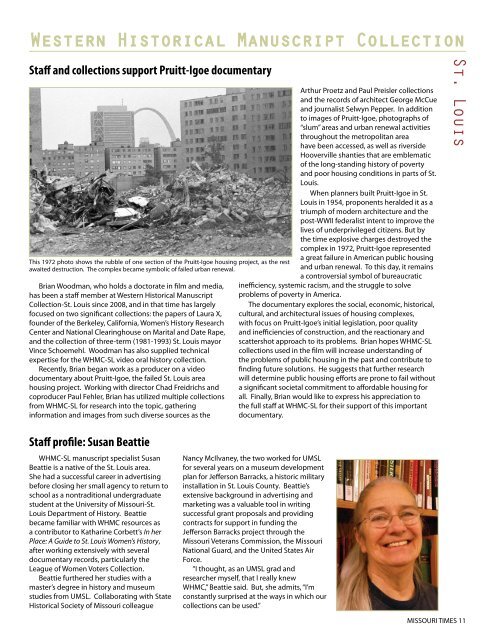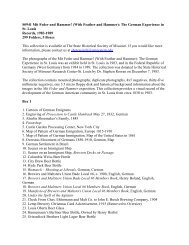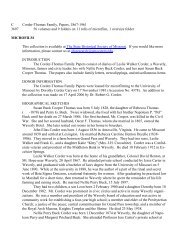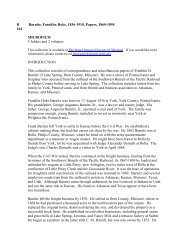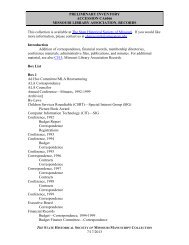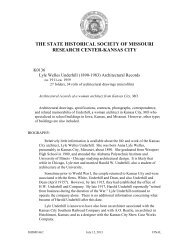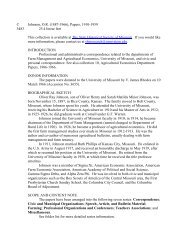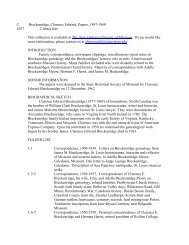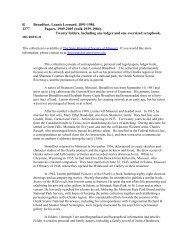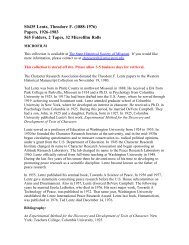MISSOURI TIMES - The State Historical Society of Missouri
MISSOURI TIMES - The State Historical Society of Missouri
MISSOURI TIMES - The State Historical Society of Missouri
Create successful ePaper yourself
Turn your PDF publications into a flip-book with our unique Google optimized e-Paper software.
Western <strong>Historical</strong> Manuscript Collection<br />
Staff and collections support Pruitt-Igoe documentary<br />
This 1972 photo shows the rubble <strong>of</strong> one section <strong>of</strong> the Pruitt-Igoe housing project, as the rest<br />
awaited destruction. <strong>The</strong> complex became symbolic <strong>of</strong> failed urban renewal.<br />
Brian Woodman, who holds a doctorate in film and media,<br />
has been a staff member at Western <strong>Historical</strong> Manuscript<br />
Collection-St. Louis since 2008, and in that time has largely<br />
focused on two significant collections: the papers <strong>of</strong> Laura X,<br />
founder <strong>of</strong> the Berkeley, California, Women’s History Research<br />
Center and National Clearinghouse on Marital and Date Rape,<br />
and the collection <strong>of</strong> three-term (1981-1993) St. Louis mayor<br />
Vince Schoemehl. Woodman has also supplied technical<br />
expertise for the WHMC-SL video oral history collection.<br />
Recently, Brian began work as a producer on a video<br />
documentary about Pruitt-Igoe, the failed St. Louis area<br />
housing project. Working with director Chad Freidrichs and<br />
coproducer Paul Fehler, Brian has utilized multiple collections<br />
from WHMC-SL for research into the topic, gathering<br />
information and images from such diverse sources as the<br />
Staff pr<strong>of</strong>ile: Susan Beattie<br />
WHMC-SL manuscript specialist Susan<br />
Beattie is a native <strong>of</strong> the St. Louis area.<br />
She had a successful career in advertising<br />
before closing her small agency to return to<br />
school as a nontraditional undergraduate<br />
student at the University <strong>of</strong> <strong>Missouri</strong>-St.<br />
Louis Department <strong>of</strong> History. Beattie<br />
became familiar with WHMC resources as<br />
a contributor to Katharine Corbett’s In her<br />
Place: A Guide to St. Louis Women’s History,<br />
after working extensively with several<br />
documentary records, particularly the<br />
League <strong>of</strong> Women Voters Collection.<br />
Beattie furthered her studies with a<br />
master’s degree in history and museum<br />
studies from UMSL. Collaborating with <strong>State</strong><br />
<strong>Historical</strong> <strong>Society</strong> <strong>of</strong> <strong>Missouri</strong> colleague<br />
Arthur Proetz and Paul Preisler collections<br />
and the records <strong>of</strong> architect George McCue<br />
and journalist Selwyn Pepper. In addition<br />
to images <strong>of</strong> Pruitt-Igoe, photographs <strong>of</strong><br />
“slum” areas and urban renewal activities<br />
throughout the metropolitan area<br />
have been accessed, as well as riverside<br />
Hooverville shanties that are emblematic<br />
<strong>of</strong> the long-standing history <strong>of</strong> poverty<br />
and poor housing conditions in parts <strong>of</strong> St.<br />
Louis.<br />
When planners built Pruitt-Igoe in St.<br />
Louis in 1954, proponents heralded it as a<br />
triumph <strong>of</strong> modern architecture and the<br />
post-WWII federalist intent to improve the<br />
lives <strong>of</strong> underprivileged citizens. But by<br />
the time explosive charges destroyed the<br />
complex in 1972, Pruitt-Igoe represented<br />
a great failure in American public housing<br />
and urban renewal. To this day, it remains<br />
a controversial symbol <strong>of</strong> bureaucratic<br />
inefficiency, systemic racism, and the struggle to solve<br />
problems <strong>of</strong> poverty in America.<br />
<strong>The</strong> documentary explores the social, economic, historical,<br />
cultural, and architectural issues <strong>of</strong> housing complexes,<br />
with focus on Pruitt-Igoe’s initial legislation, poor quality<br />
and inefficiencies <strong>of</strong> construction, and the reactionary and<br />
scattershot approach to its problems. Brian hopes WHMC-SL<br />
collections used in the film will increase understanding <strong>of</strong><br />
the problems <strong>of</strong> public housing in the past and contribute to<br />
finding future solutions. He suggests that further research<br />
will determine public housing efforts are prone to fail without<br />
a significant societal commitment to affordable housing for<br />
all. Finally, Brian would like to express his appreciation to<br />
the full staff at WHMC-SL for their support <strong>of</strong> this important<br />
documentary.<br />
Nancy McIlvaney, the two worked for UMSL<br />
for several years on a museum development<br />
plan for Jefferson Barracks, a historic military<br />
installation in St. Louis County. Beattie’s<br />
extensive background in advertising and<br />
marketing was a valuable tool in writing<br />
successful grant proposals and providing<br />
contracts for support in funding the<br />
Jefferson Barracks project through the<br />
<strong>Missouri</strong> Veterans Commission, the <strong>Missouri</strong><br />
National Guard, and the United <strong>State</strong>s Air<br />
Force.<br />
“I thought, as an UMSL grad and<br />
researcher myself, that I really knew<br />
WHMC,” Beattie said. But, she admits, “I’m<br />
constantly surprised at the ways in which our<br />
collections can be used.”<br />
St. Louis<br />
<strong>MISSOURI</strong> <strong>TIMES</strong> 11


